|
|
Post by codystarbuck on Dec 14, 2019 15:55:44 GMT -5
We have all heard of the real superstar writers in the world of comics; names like Alan Moore, Neil Gaiman, Frank Miller, Denny O'Neil, Chris Claremont, Roy Thomas, Marv Wolfman, Len Wein, Jim Starlin; and, of course, Stan Lee. We've seen the occasional outsider come in and dabble a bit in comic stories, like Kevin Smith, Joss Whedon, Tamora Pierce, Jodi Picoult and even John Cleese. Then, there are the writers who kind of slip in and leave a quick impact, in between higher paying gigs. Don Glut was one of these, writing stories for Western/Gold Key, when he wasn't writing the novelization of the Empire Strikes Back or episodes of Transformers. One of the best dabblers in comics, for my money, was Alan Brennert. Brennert is an Emmy (producer, LA Law) and Nebula Award ("Ma Qui"", 1991)-winning writer, who has written and produced for television, written for the stage, prose novels and short stories and comic books.His first dabbling in comics came in 1975, in Unknown Worlds of Science Fiction #4 and 5, where he conducted interviews with AE Van Vogt and Larry Niven; and Special #1, with Ted Sturgeon.    Brennert was then working in television, where he would write 4 scripts for Wonder Woman, after it moved to CBS, including "The Girl With a Gift For Disaster," "Amazon Hot Wax," "Skateboard Wiz," and "Disco Devil." Don't blame him for the silliness, though; it came with the approach for the show. Wonder Woman even got her infamous skateboarding outfit for "Skateboard Wiz,"....  Why would someone super strong and mostly invulnerable need a helmet, knee & elbow pads? To set a good example for the kids; so shut up!  However, Brennert already had experience with Wonder Woman, as his first comic book story would appear in Wonder Woman #231, which is our first subject. |
|
|
|
Post by codystarbuck on Dec 14, 2019 17:08:57 GMT -5
Wonder Woman #231 Very 1970s hair for the 1942 Steve Trevor. Not to mention, the uniform is wrong. Creative Team: Alan-Brennert-story, Marty Pasko-script, Bob Brown-pencils, Vince Coletta-inks, Jerry Serpe-colors, Denny O'Neil-edits Alan Brennert was in college and was a friend of Marty Pasko. He wrote the story to earn some fast cash, with Pasko turning the story into an actual script. The Wonder Woman comic, at this point, was telling stories of the Golden Age Wonder Woman, in 1942 (ish), in response to the first season of the Wonder Woman tv series, on ABC. Steve Trevor is also depicted with brown hair, to more closely match Lyle Waggoner. Synopsis: The date is 1942 and a German and a British tank face off, alone, near a mysterious pyramid (this is not Giza, apparently)...  The panzer misses and blows a hole in the pyramid, releasing strange energy, which incinerates both tanks. We jump ahead to 1943 and Steve Trevor is in the Pentagon (construction was completed in Jan 1943 and occupation of facilities began as soon as each wing was completed) and he mentions another routine assignment. However, in Egypt, a mummy awakens int he strange pyramid and we are told that Steve is a key figure in the future of the Earth. The mummy sheds her wrappings and reveals Osira, who has been trapped there for 3 millennia. She flies off in an energy pyramid. Back in Washington, Steve and Diana Prince look out a window and witness a strange sight, which has Steve tear out of the building, followed soon by Wonder Woman, in her invisible plane. We see the Capitol dome replaced by a pyramid, while Congressmen inside demand an end to the war!  Radio reports of peace breaking out stun Steve and WW. WW rips the pyramid structure off the Capitol, which breaks the spell over Congress. They suspect that the "peace" is being imposed from outside and fly to Egypt to investigate. Steve questions her opposition to this peace, since that is her mission. She replies that peace cannot be forced by others, that you can't just order people not to hate. She could do that much with her magic lasso; but, it wouldn't last. They are attacked by a joint flight of Messerschmidts and Spitfires. Steve voices my question, about how they can see them to attack and WW responds that the plane is invisible; they aren't. (well, that's a new wrinkle). WW uses her bracelets to deflect bullets, including those from a British pilot's sidearm, after he opened his canopy to shoot at her. She uses her lasso to get him to call off the attack. They land and ge says he serves Osira. They head for her pyramid and are attacked by German soldiers, with Egyptian head wraps, then the lady, herself. Wondy and Osira battle an Osira reveals her "powers" are the result of alien technology. She captures Wondy in an energy pyramid and reveals that she and her husband, Hefnakhti (we'll just call him Hef) conquered ancient Egypt, by appearing as gods. They gave them new technology and had the pyramids buil;t. A priest, Anankh, spoke against them and they imprisoned them in a pyramid. They broke free, but expelled all of their energies. They were mobbed and mummified alive, prisoners of the pyramid.  Now, she intends to reconquer, with Steve by her side (who is getting his butt kicked by Jerries and Tommies). Wondy says she'll never get away with it, that the JSA will stop her and she shows Wondy the JSA members imprisoned in similar energy pyramids, while she plants a lip lock on Steve. Thoughts: This would have been a pretty decent episode of the tv show, maybe a two-parter (they did have one with an alien visitor, in that first season). It has an interesting idea, of Wonder Woman having to stop an alien from imposing their own "peace" on the world, so they can conquer it. Is it worse to let that happen and save millions of lives or is it better to stop he and restore free will? Quite an ethical dilemma. The execution is another matter, though. It hall gets thrown out there rather quickly and the philosophical has to be dispensed with in a couple of panels; plus, we get a big info dump. Also, we get conflicting word if this is Giza or not, as we do see the Sphinx from above. I think Bob Brown is using familiar iconography, though it makes it confusing. As it is, his military accuracy is pretty low. Osira gets little development, aside from a background that is one part Von Daniken and another Universal's The Mummy. Bob Brown's art, with the Coletta inks, is pretty mediocre. This is not the same Bob Brown who was drawing Daredevil, on Len Wein and Marv Wolfman's stories. Well it is, but not with the same level of quality. Detail is definitely not a priority here and the JSA members look like mannequins. Osira looks like an Egyptian-themed stripper, minus high heels. The letters page tells us that Brown is the new regular penciler for WW, and reminds us of his past, at DC, an recent time at Marvel. Brown relates his own background, serving as a navigation officer on B-29s, during the bombing campaigns over the Japanese home islands, earning 6 air medals and the Distinguished Flying Cross. I, thus, have a suspicion that the lack of detail and accuracy in the military elements is down to Coletta's notorious habit of simplifying the pencil drawings, as he inked. Either that or a time crunch. Brown was about 60, at this point, which might also be a factor. The Daily Planet supplement tells us that DR Light will be seen in DC Super-Stars #14, a Secret Origins of Supervillains issue, and that the New Gods are returning, at the hands of Gerry Conway. The Injustice Society returns to face the JSA, in All-Star #66 and Batman Family #11 has Robin and Batgirl forced into marriage! Detective has the beginning of Steve Englehart's run, with Walt Simonson drawing the origin of Dr Phosphorus. Not the most auspicious beginning for Brennert, though he was still a college student and he didn't actually write the script. Brennert would be writing for the tv series the next year, then move on to Buck Rogers, where he also was a story editor. He would then write for such shows as Simon & Simon, the revived Twilight Zone, LA Law, Stargate Atlantis and Star Trek Enterprise. Harlan Ellison sung his praises on Twilight Zone. Next, part two of the Wonder Woman story. Cue up the Bangles...
|
|
|
|
Post by Slam_Bradley on Dec 14, 2019 17:26:03 GMT -5
I picked that up issue (and the following one) as back issues when I was buying anything I could find that was Earth-2 related. Until this moment I had no idea that Brennert was involved. I honestly have no memory of the book at all. It's been well over 30 years since I read it and I know I got it, read it once and it got filed away and hasn't seen the light of day since. Wow...Bob Brown and Vince Colleta. That is as generic as art gets.
The first couple years of undergrad The Bangles were on HEAVY rotation on MTV. Any time they came on there would be a yell through the fraternity house, "Bangles are on MTV!" Not that anyone really cared about the music. It was all about drooling over Susanna Hoffs.
|
|
|
|
Post by codystarbuck on Dec 14, 2019 20:36:14 GMT -5
I picked that up issue (and the following one) up as back issues when I was buying anything I could find that was Earth-2 related. Until this moment I had no idea that Brennert was involved. I honestly have no memory of the book at all. It's been well over 30 years since I read it and I know I got it, read it once and it got filed away and hasn't seen the light of day since. Wow...Bob Brown and Vince Colleta. That is as generic as art gets. The first couple years of undergrad The Bangles were on HEAVY rotation on MTV. Any time they came on there would be a yell through the fraternity house, "Bangles are on MTV!" Not that anyone really cared about the music. It was all about drooling over Susanna Hoffs. I saved my drool for bassist Micki Steele. Okay, that sounds really disgusting. Really underrated band; great harmonies and damn good musicians. Better singers than the Go-Gos, though the Go-Gos could wail on their instruments with the best of their male contemporaries, especially Kathy Valentine and Charlotte Caffey. They could also party as hard, as related in liner notes in Beyond the Valley of the Go-Gos. |
|
|
|
Post by codystarbuck on Dec 15, 2019 16:02:55 GMT -5
Wonder Woman #232 Wonder Woman is a big hit on tv, one of your oldest characters, her sales haven't been much in quite a while; so, who do you get to do a cover? Mike Nasser? Man, it was a long haul for Jenette Kahn to turn that company around! Vince Coletta as Art Director was not helping. Creative Team: Alan Brennert-story, Marty Pasko-Script, Mike Nasser-pencils, Vince Coletta-inks, Liz Berube-colors, Denny O'Neil-edits Synopsis: When last we left her, Wondy was imprisoned in an energy pyramid by the alien conqueror Osira, as were members of the JSA. Steve Trevor was under her spell. Wondy is out and Osira has some Kraut flunkies carry her off to her cell; but, Hans has left her the magic lasso, as he thinks it is inconsequential. The Master Race, ladies and gentlemen! He and Fritz move off to avoid Mama and trick der Kapitan. Wondy is playing possum and tries to use the lasso on the cell; but it doesn't work. However, the pyramid is over her and the original floor is below. So, Wondy wraps her lasso around her and uses it as a pull-chord and turns herself into a top, while her bootheels dig into the floor...  Now that's innovative! She digs under the pyramid and breaks free on the other side. Meanwhile, Steve Trevor asks Osira to relate her origin, again, so we go through that one more time. She also explains that Steve is the spitting image of her hubby, Hefnakhti (Hef). She then throws a pyramid whammy on Steve and Hef's personality takes over Steve's body. Wondy ain't having some alien hussy taking her man; so, it's catfight time! She punches the energy pyramid and dents it and then narrowly avoids an energy bolt. She then lans one, right into Osira's mush! Steve tackles her and now she has to lay out Trevor, with a haymaker. Osira is POd and releases the JSA, with an energy bolt and sicks the mind controlled mystery men on the Amazonian Princes. She picks up Steve and digs her stilettos in to make like the Road Runner. Wondy uses the "infinite elastic" lasso to hurl miles to Giza and catch the Sphinx, then slingshot away from the JSA. However, Starman flies after her, towing Atom and Mr Terrific. Osira orders Sandman and Johnny Thunder to follow. He summons the Thunderbolt and off they go. Mr Terrific tries an acrobatic aerial attack on Wondy and gets slammed into the ground. Atom hits her with a chauvinist punch to the back of the head and she knocks him out with her tiara, while making fun of his size. She uses her lasso to deflect Sandman's sleep gas, then smashes his pistol with her bootheel. Awfully tough heels she has. Starman decides he isn't playing and drops the Sphinx on her!  She survives and is distracted deflecting energy from the Gravity Rod. Johnny orders the Thunderbolt to attack her and he argues that he can't attack a fellow JSAer. Johnny overrides him and orders him to give Starman a hand. Thunderbolt uses a time honored military revolt and follows his order to the letter, hitting Starman with a giant hand, while Wondy lassos Johnny and orders him to obey. Osira turns up and attacks and Wondy grabs the Gravity Rod and destroys her energy pyramid and tells her that her mind control is greater tyranny than Hitler. Um, I think the millions that died in the Holocaust might disagree with that. Wonder Woman engages in a debate with Osira and sways Hef into convincing her to stand down and join him in Eternity...  Steve and the JSA are released from the spell. The JSA head off, except Starman, who stays to clean up. Wondy and Steve fly off and she tells Steve that the war is back on and she hopes the men are satisfied. Steve responds that it is her war, too, like it or not and she sees the point. Thoughts: The letters page explains that Bob Brown was hospitalized, soon after finishing the previous issue, so Mike Nasser steps in. That might partially explain why it didn't look as good as some of his other work (aside from the lackluster Coletta inks). Nasser gives it sharper images and figures, in contrast to his less than great cover. We are further told that Don Heck and James Sherman will be upcoming artists and Gerry Conway is replacing Pasko. Pasko was doing Superman, around this time and his stories there were better than his Wonder Woman stuff. Brennert conceived a decent story, with the second part far better than the set up. He uses a bit of strategy to get Wonder Woman out of her prisoner, even if it looks a little fetishy under Nasser's pencils, as seen above. I also think that may have been the first time that someone referred to WW wearing "spiked heels." It seemed a bit silly to call the heroine Osira, when Osirus was a male god; but, DC had already done an Isis comic, based on the live action Filmation series and probably didn't want to go that route. Hefnakhti is a total fake name; so, no one did any research into Egyptology. With that ame, I expected him to have an Egyptian headpiece and a smoking jacket. Osira did look like an Egyptian version of a Bunny. Brennert shows some flair for the tv show and adds a moral lesson to things, hinting at greatness to come, but it is all filtered through Pasko. The letters page says some are not happy about Earth-2 Wonder Woman adventures. Some, including future novelist and comic writer Robert Rodi suggest Earth-1 WW stories in World's Finest; but the editors say that is too confusing. As it is, they played fast and loose with the truth on the covers, making it look like modern WW stories, then drawing more of the GA Wondy inside, though it ends up closer to the moden WW. Brennert would return to comics, in earnest, in 1981, which is where we will pick up this thread, next time.
|
|
|
|
Post by Slam_Bradley on Dec 15, 2019 16:13:54 GMT -5
I know I own that comic as well but I have absolutely no memory of it. Which is likely because I haven't read it since I bought it. It seems like Nasser was a bit of a fan favorite at the time but that's fairly rough work. I'm sure the time constraints didn't help. I was not and am not a Pasko fan, so I'm unlikely to re-visit this even with Brennert involved. DC really was a mess at this point. I didn't realize it at the time (being 9 or ten years old) but Kahn had her work cut out for her. The super-hero books were particularly dire.
|
|
|
|
Post by badwolf on Dec 16, 2019 11:53:41 GMT -5
I mainly associate Brennert with the 1980s Twilight Zone series.
|
|
|
|
Post by rberman on Dec 16, 2019 12:14:18 GMT -5
Wonder Woman #231 Thoughts: Thoughts: Osira gets little development, aside from a background that is one part Von Daniken and another Universal's The Mummy. Bob Brown's art, with the Coletta inks, is pretty mediocre. This is not the same Bob Brown who was drawing Daredevil, on Len Wein and Marv Wolfman's stories. Well it is, but not with the same level of quality. Detail is definitely not a priority here and the JSA members look like mannequins. Osira looks like an Egyptian-themed stripper, minus high heels. This issue was in my cousin's stash of 1970-1972 DC comics that I read ten years' later. I suspect his eye was drawn by the cover image of Wonder Woman sticking her chest out. I suppose mine was too. It was also the first comic I ever read containing the JSA, and I remember well this image of them. Who are those guys? How weird to have "FAIR PLAY" emblazoned across your chest. This page is actually up for auction this week.  |
|
|
|
Post by mikelmidnight on Dec 16, 2019 13:14:45 GMT -5
It seemed a bit silly to call the heroine Osira, when Osirus was a male god; but, DC had already done an Isis comic, based on the live action Filmation series and probably didn't want to go that route. Hefnakhti is a total fake name; so, no one did any research into Egyptology. With that ame, I expected him to have an Egyptian headpiece and a smoking jacket. Osira did look like an Egyptian version of a Bunny. We can chalk it up to the Egyptian mythology of Earth-2? I once wrote up an account of the Olympic pantheon as depicted in 40's Timely comics, which were an odd mélange of Greek, Roman, and Norse names. |
|
|
|
Post by Roquefort Raider on Dec 16, 2019 13:45:00 GMT -5
I'm glad to see Brennert getting some attention... His Daredevil #192 was excellent.
|
|
|
|
Post by codystarbuck on Dec 17, 2019 1:21:39 GMT -5
Star Trek #12 Creative Team: Creative Team: Alan Brennert-plot, Marty Pasko-script, Luke McDonnell-pencils, Tom Palmer-inks, Joe Rosen-letters, Carl Gafford-colors, Louise Jones (Simonson, eventually)-edits Brennert is still not writing the entire script. This was part of Marvel's short-lived run with the Star Trek license, following Star Trek The Motionless Picture.....er, Motion Picture. Synopsis: Stardate 8180.7 Captain Kirk is sending off his former yeoman and bedwarmer, Janice Rand... 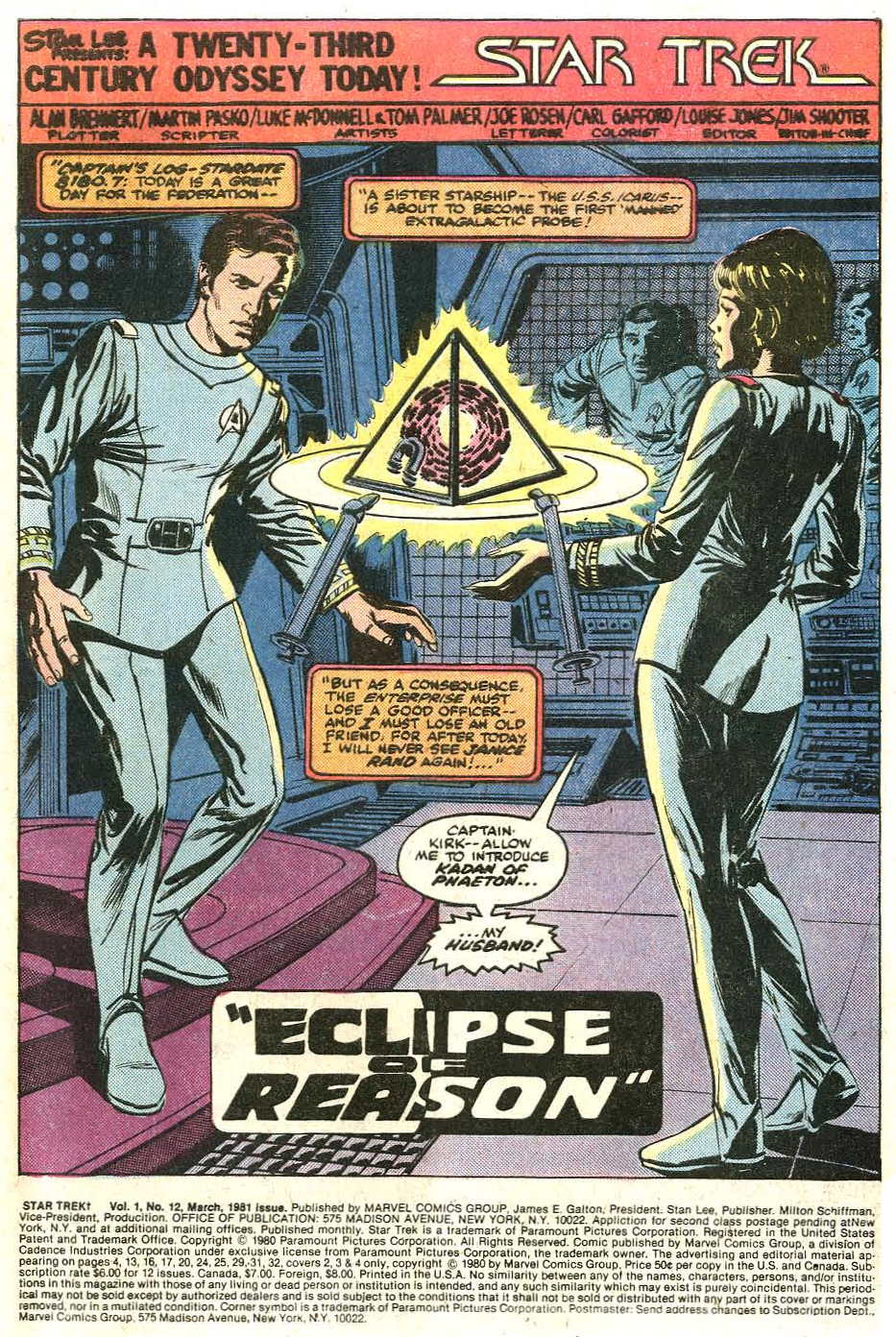 She and her husband Kadan will be departing on the USS Icarus, with a crew of Paetons, alien entities with no bodies. The Enterprise and her crew are prepping it to depart the galaxy.Rand has jumped from Chief Petty Officer, in STMP to Commander. Sheesh, I had to go through lieutenant (junior grade) and I started as an ensign! The mission will find Rand as the sole human on the vessel, which is not scheduled to return, in her lifetime. Spock thinks the Phaetons are pretty cool; the rest are a bit spooked. Kirk questions Rand, mentioning that she left to months before and came back married to a being of pure energy.. Janice gives it right back to him... 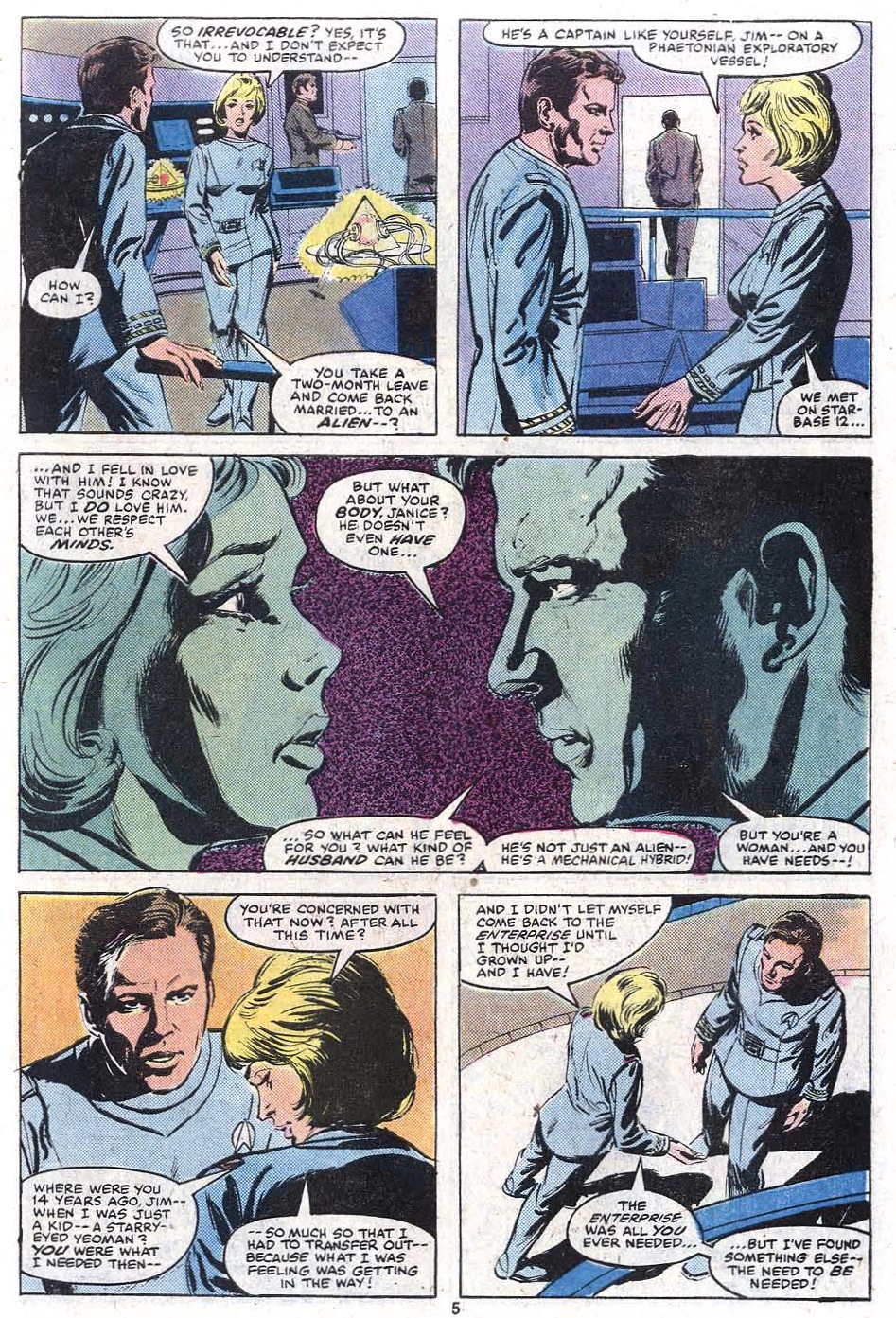 The Enterprise departs and the Icarus pierces the energy barrier at the edge of the galaxy, which the Enterprise once pierced. The Phaetons glow and then a mental bolt sears through Rand's brain and the ship is hurled back into the galaxy from whence it came. Rand has telepathic contact with the Phaetons, especially her hubby, who has gone nuts. So have the rest. They soon attack and destroy a cargo ship and Rand has no control over the ship. On the Enterprise, Spock receives a telepathic distress call. He takes Kirk into a private area and tells him the message is from Rand, outlines the situation and cross references the image of the star system on the Icarus monitors with their charts. Kirk orders his ship to break off their mission and head to lend assistance. They arrive to find the Icarus speeding through an asteroid field, with sentient life on some of the objects. They pursue cautiously. The Icarus has shields up, so Rand can't be teleported off. She sends a message to Enterprise. The Phaetons are being driven by a desire to return home and "land" the ship, which would take it down in a populated area. Kirk and his crew work to find a solution. They punch a hole through the Icarus' shields and land a boarding party, through the transporter, without their Perscan Devices, to avoid setting off their intruder alert. That makes them incommunicado. They launch the mission. After beaming away, the Enterprise takes a return hit from Icarus and engineering is damaged, leaving impulse power only. They affect repairs. Kirk and his team beam into engineering and try to take manual control; but, the Phaetons have a forcefield over the controls. They try a turbo lift and are dumped into freefall. Spock orders phasers to be used and the lift halts at a gymn level, where mechanical sparring machines attack the raiders. They are able to defeat the machines and Spock sends a telepathic message to Rand, leading her through a Jeffries tube to them. On the Enterprise, Scotty briefs the crew that they have orders to stop the Icarus at all costs. They are expendable. 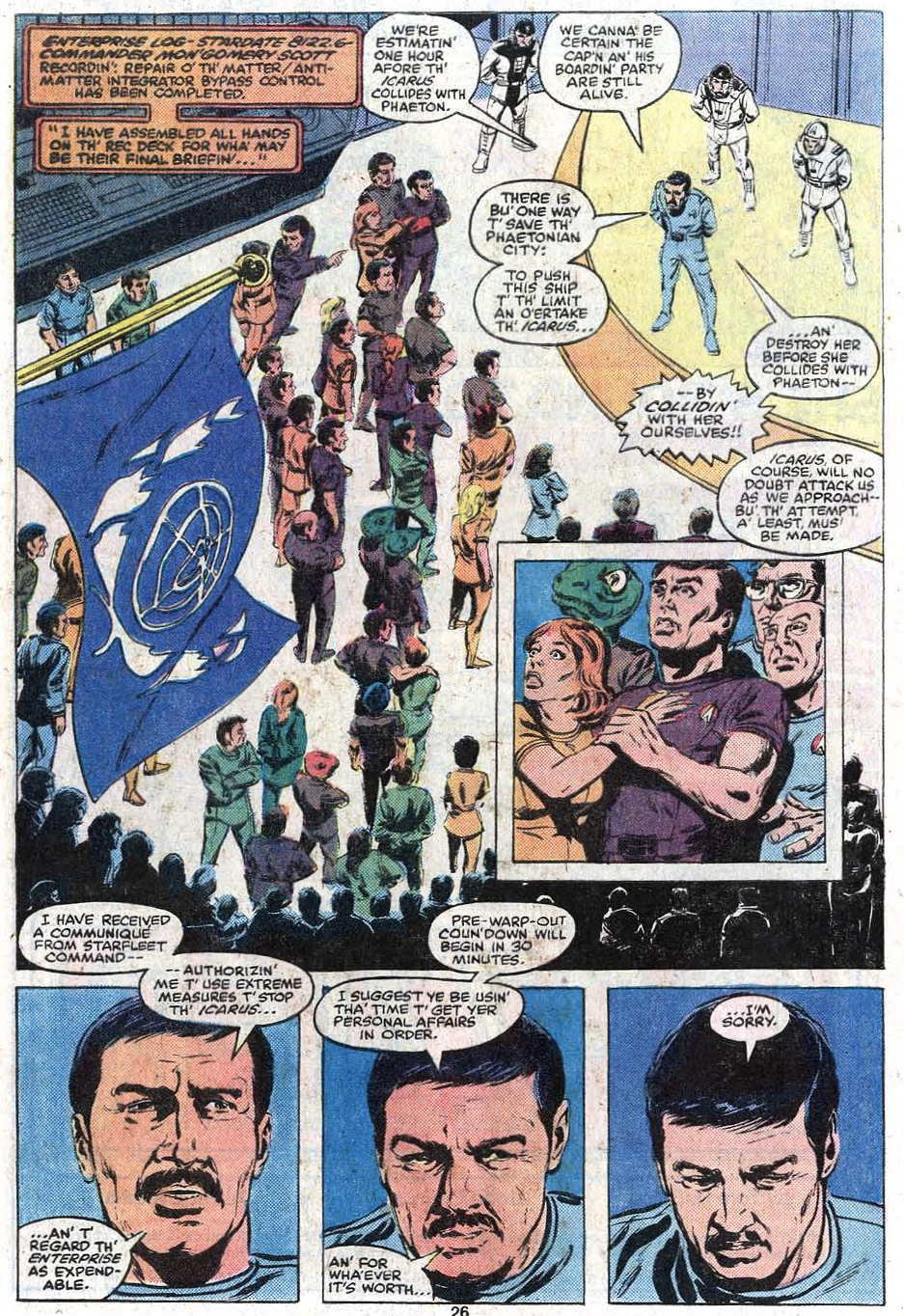 On the Icarus, Spock and Rand touch the Phaeton minds. Kadan shuts off artificial gravity and life support to stop them; but, Kirk gets to the manual override. The Icarus diverts from Phaeton and the ship is stopped. Rand recovers on Enterprise, while the Phaetons are transported to Elba II for treatment. Rand returns to the Enterprise crew as Transporter Chief. 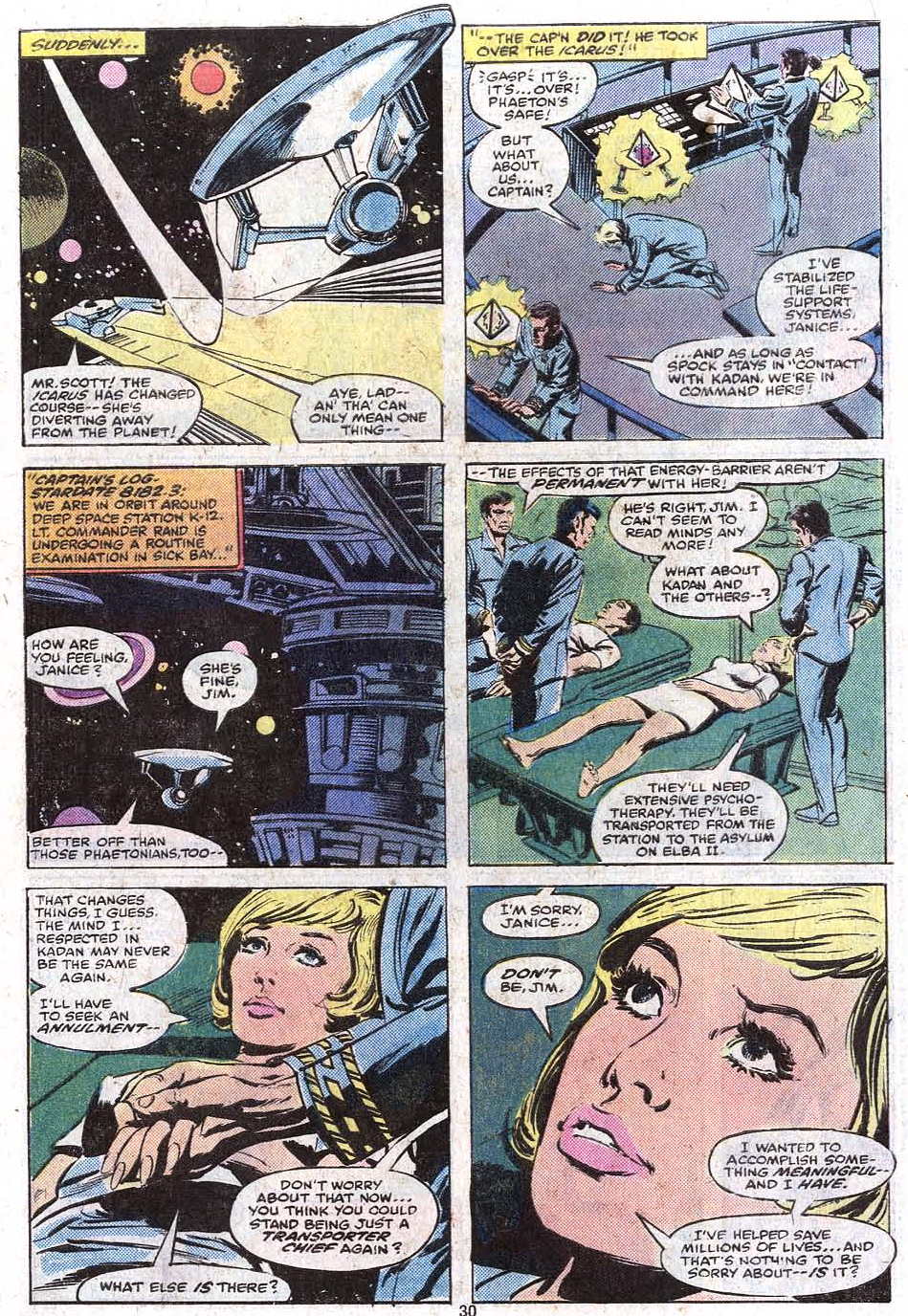 Thoughts: Thoughts: Interesting story, with Janice Rand given a spotlight. Grace Lee Whitney had been forced to leave the series with personal issues and did not return until STMP, where she had a cameo as the transporter chief, when LCDR Sonak and a human crew member attempt to beam aboard and an accident merges their bodies. The story addresses the implied romance between Kirk & Rand, from TOS amd Kirk questions her sudden marriage to an energy being. This plot point never gets fully developed as it would almost seem that Rand is manipulated into things, though Kadan only goes nuts when they hit the barrier. I have to think a more mature Brennert would have developed this more, had it been for one of the novels. As it is, we see more of the talent that Brennert would display in his future writings, though a bit inhibited by the approval structure of the Star Trek licensed comics, where Paramount was notorious for being very picky. Brennert gives some life to Rand, both with her past and her willingness to leave humanity behind to see beyond the veil, knowing she won't be returning. It's a one way mission, with a husband with whom she cannot physically bond. Kirk even addresses this point, lending a maturity to things that even Star Trek rarely addressed. Kirk speaks of Rand's physical needs with her, but she suggests their communication is beyond the lhysical, though we see no example of this, before the accident. Brennert demonstrates his ability to write complex characters, including women, who were often under-written in comics or only in relation to the male characters. Rand gets more personality than she had in most of her episodes. Luke McDonnell and Tom Palmer do a fine job on the visuals, with decent likenesses and interesting panels. From here, Brennert returns to DC, to write his first Batman story, a chapter of Detective Comics #500. All in all, it's a pretty decent story, which blends olf Trek with the world of the movie, before Nicholas Meyer breathed some excitement into things.
|
|
|
|
Post by codystarbuck on Dec 18, 2019 1:08:39 GMT -5
Detective Comics #500 Check that out; Walter Gibson, creator )of the pulp version, not the radio host that predated the hero)and main writer of the Shadow, contributed a story. In his prime, at the height of popularity, Gibson turned out two Shadow pulps a month/ He wrote 293 of the 336 Shadow stories. "To Kill a Legend." Creative Team: Alan Brennert-writer, Dick Giordano-artist, John Costanza-letters, Adrienne Roy-colors, Paul Levitz-edits Synopsis: Bruce Wayne is plagued by the nightmare of his parents' murder. he hasn't had it in years, since he caught Joe Chill. He suits up and goes out looking for trouble and soon finds it, rescuing an old woman from muggers. Batman chases one of the perps down a dead-end alley, only to find that it opens up on Crime Alley, which is shrouded in a mysterious fog. Robin turns up and decks the fleeing criminal. He is supposed to be on a plane to Europe and he doesn't know how he got there. The Phantom Stranger turns up and tells them they are here because they are needed. They are on a parallel world, where another Bruce Wayne is about to lose his parents, unless Batman and Robin can stop it...  Batman accepts the offer to change what happened in his past and tells Robin he has to go alone; but, Robin doesn't listen. They end up in Gotham Harbor and run into some crooks. The7y try to nab them and they faint when they touch them. Lt Gordon and the police turn up and try to arrest the masked men and they escape. They notice that things are different, with street names slightly altered. They go to the public library to find a social register, to locate Dr Thomas and Martha Wayne. Librarian Barbara Kean, fiancee to Lt Gordon (and look alike for Barbara Gordon, calls Bruce Dr Wayne, believing he is his father. She shows him the social register, while Dick goes off to poke around. He finds that there are no costumed heroes mentioned in newspapers and further finds that there is no heroic literature or mythology. He also discovers there is no red star in the sky where Krypton would be orbiting; thus, no Superman to come to Earth.  They locate the Wayne's home and head out to it and spy on Thomas and Martha Wayne, as they deal with young Bruce, who is throwing a tantrum. He's a complete little brat. Meanwhile, petty crook Joe Chill has come into town, after leaving Cleveland, where he pulled a job and his accomplice was caught. He is scared and edgy and looking for his contacts in Gotham. Batman and Robin leave and head to police headquarters, where Batman goes inside, disguised as Lt Gordon. He is looking for intel on Joe Chill but finds no files. He does locate info on Lewis Moxon, who hired Chill. He has a trucking company and Batman goes to bust up the joint. Moxon denies knowing Joe Chill and Batman threatens him, mentioning the Waynes. Moxon's thoughts reveal he was planning to kill them and has to move upo his timetable. Chill gets into town and goes to find Moxon, on recommendation of his accomplice in Cleveland. Batman and Robin return to the Wayne Estate and watch and argue...  Robin believes they have no right to interfere and that maybe it is better to let this world have a Batman. Batman cannot let another young boy go through what he did, growing up angry all the time. Batman leaves to check interstate records about Chill and Robin overhears the Wayne's leaving to see a movie. He recognizes the event and follows. Batman locates the records he seeks. Jim Gordon catches him and has him at gunpoint. Batman reasons and appeals to the friendship they share on another world. Gordon lets him go. Robin watches as the Waynes head down a street and wonders where Batman is. Gordon passes on info from a snitch and locates Chill's flop house room and finds him dying. Moxon is responsible. Batman can't understand why events are proceeding differently, as he should have 5 days. He then realizes that 20 years have passed since his "birth" and that there were 5 leap years, with 5 extra days (convenient) and that it is today, not on the 26th, as he thought. He rushes off. The movie was sold out and the Wayne's return, while Bruce whines. One of Moxon's men steps out to accost them and Robin is too far; but, batman is there and deflects the hand pulling the trigger and disarms the crook, who runs. The Waynes are safe. Batman catches the crook and knocks him out with a backfist to the jaw. Robin catches up and the fog returns, as Phantom Stranger shows up. They have done the job and it is time to go. They leave with the stranger. In the end, we see the path of this world's Bruce Wayne, the spoiled litle boy who was spared the deaths of his parents before his eyes, by a masked man...  Thoughts: Thoughts: Detective Comics #500 was a celebration of the comic and the detectives who appeared in it. Batman gets the lion's share; but, other stories feature Hawkman (a cop), Deadman (who searched for his killer), Elongated Man (detective and back-up feature in the book), and a slew of detectives and adventurers, who team up with Slam Bradly, Siegel and Schuster's private eye (including Roy Raymond, Jason Bard, Christopher "Human Target" Chance, Pow-Wow Smith, Mysto, and Captain Compass). Len Wein and Walt Simonson do a silent story, with only narration, spoofing Edward Bulwer-Lytton's opening lines from the novel Paul Clifford. It is filled with the cliches that make up the Bulwer-Lytton Fiction Contest, which was launched in 1984, to find the worst opening lines, with rapid changes in POV. Mike Barr penned a mystery with Elongated Man. However, this is about Alan Brennert. By this point, he is a published novelist (Plague of Masks), tv writer (Wonder Woman, Buck Rogers) and comics fan with three plots published. This time, he handles his own script. He takes Batman and Robin into an alternate world, where heroes do not exist, either in life or literature. He is compelled to prevent the murder of "his parents," and make sure his young counterpart will not suffer as he did. brennert presents a spoiled little Bruce, prone to tantrums. This world has no heroes and Robin wonders if it might be better if Batman is born to this world. Batman asks how he can think that, as his own parents were murdered? Early on, Robin's thoughts say Batman doesn't think clearly where his parents are concerned. It's an interesting philosophical argument, similar to the one raised in Harlan Ellison's "City on the Edge of Forever," in Star Trek. Brennert sets up a puzzle for Batman to solve, as the world is different enough that things don't progress as they did on Earth-1. Locations are different, people are different. The circumstances are different. Batman is frantic to solve things. His mission has never hit home so much as this. In the end, he accomplishes both tasks; he saves the Waynes and inspires this world's Bruce to be a force for justice, as he turns to Sherlock Holmes, criminology and physical fitness, in a quest to become like the man who saved his parents. It is a counterpoint to a hero created in tragedy. This one is inspired by triumph. Perhaps this world's Batman can be a force for good and have a life beyond. Perhaps he can come to embody the best attributes of Batman and Superman. Time will tell. Brennert had 19 pages, which was nearly a full comic, atthis point, though he had enough story to go further. Some things demand more exploration and I suspect he would have, with more room. One of the things I like about Brennert's stories, so far, is that his heroes use their brains, more than their brawn. Wonder Woman reasoned her way out of her prison and used reason to end Osira's domination of the Earth, knowing that war would resume. Janice Rand and the Enterprise crew must solve the problem of the mad energy beings, using plans and strategy, to avert a disaster. Batman and Robin must search for clues and people in a world slightly different from their own. The physical occurs, but the mental is just as much, if not more important. Too many heroes these days punch first and last, with nary a thought in between. Too many writers are incapable of crafting a mystery or a situation that requires logic and reason to guide the hero towards a strategy, which they then employ. Conspiracies are substituted and heroes too often punch their way through a problem, blundering from one betrayer to the next before the end comes, without being earned. There is brain food in Alan Brennert's stories. There is also philosophy and heart. This story is part of a milestone. It would also be included in Best of DC Digest #23, and then The Greatest Batman Stories Ever Told, Batman in the Eighties, Tales of the Batman: Alan Brennert, Detective Comics: 80 Years pof Batman, and Detective Comics: Batman 80th Anniversary Giant. Think about that; it has been reprinted nearly every decade since it was written and it was Brennert's first Batman story! It's not his last.
|
|
|
|
Post by codystarbuck on Dec 19, 2019 20:15:56 GMT -5
Te Brave & The Bold #178 Creative Team: Creative Team: Alan Brennert-writer, Jim Aparo-artist, Adrienne Roy-colors, Dick Giordano-edits Dedicated to Steve Ditko Synopsis: In Gotham City, Batman is hit by a whirlwind of paper as he enters an alley and finds a dead man, the latest in a series of killings. All of the victims had a string of paper dolls left on their body. This one had bits of paper under his fingernails and printers ink on his hands. Victims have ranged from junkies to drunken college students. 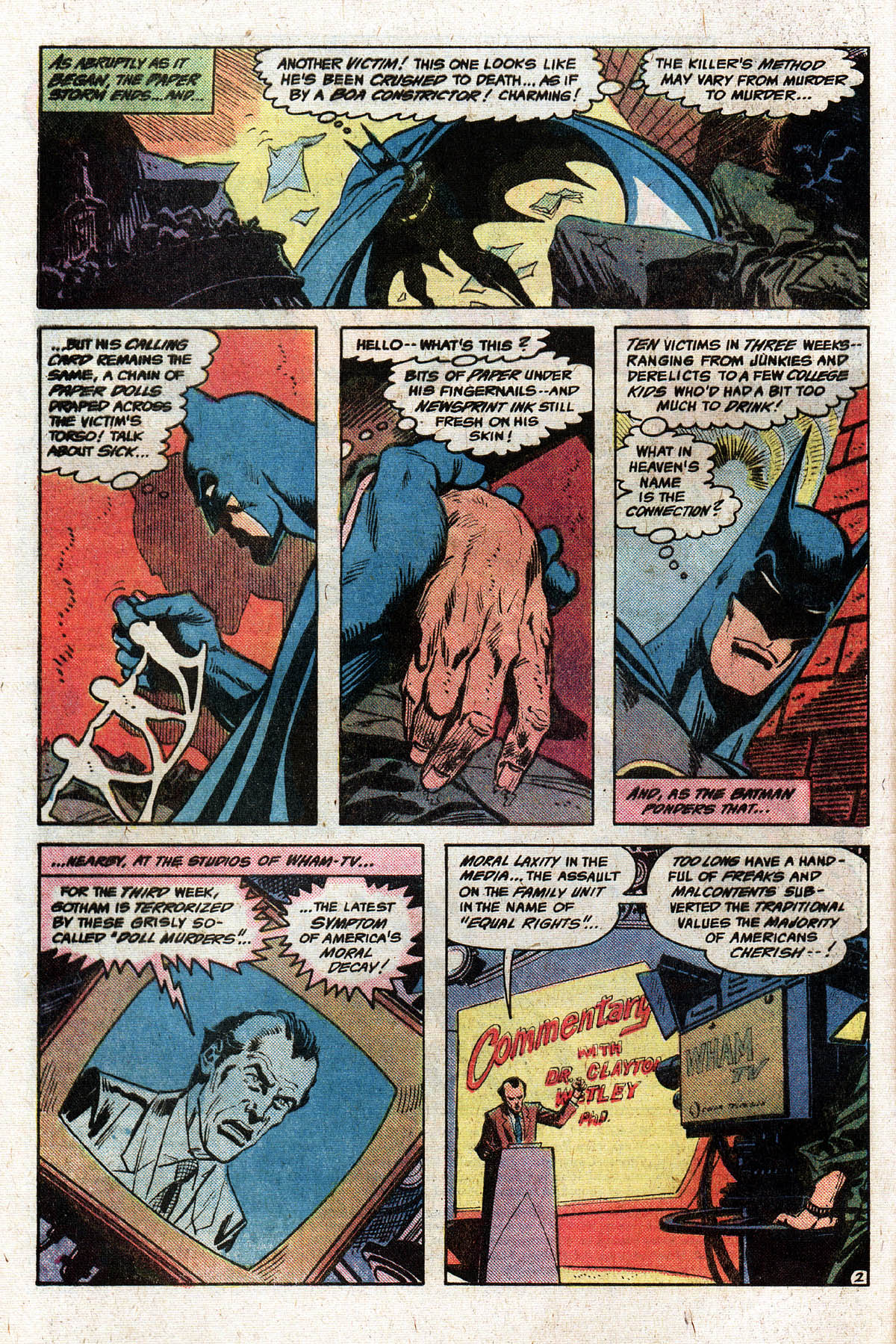 At WHAM-TV, Dr Clayton Wetley attacks the moral decline, caused by a media assault on traditional values, in the name of equal rights, as evidenced by the killer. Jack Ryder watches from the side and chastises the station manager for giving a platform to a reactionary loon (ironic, given the Creeper's early days). Ryder has given up neswcasting for security, to better free himself to be the Creeper. A sensationalist reporter is chasing a lead on the next victim and Creeper runs into Batman and a very odd killer... 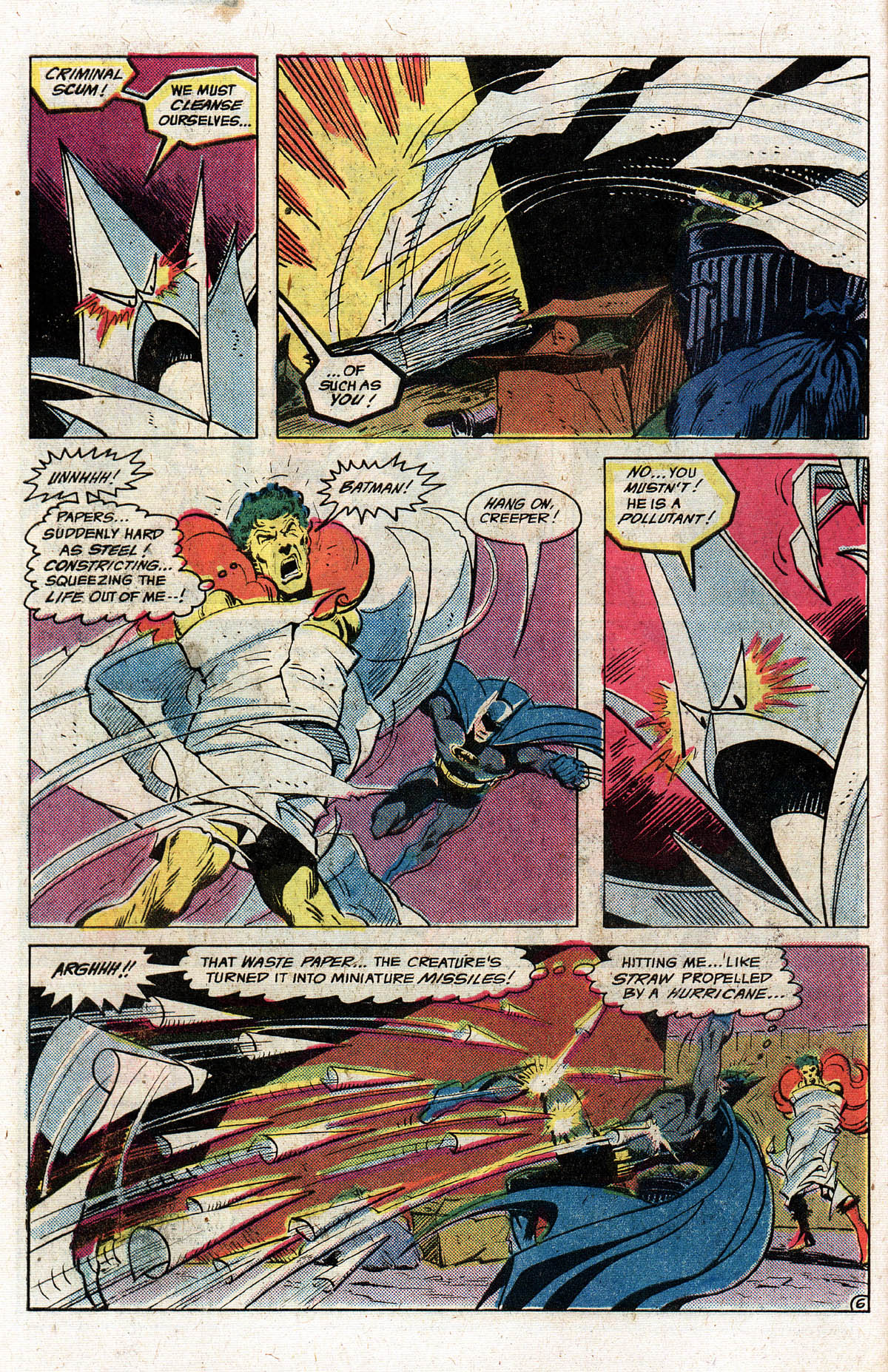 Meanwhile, Wetley's tirades have a mob stirred up. Batman burns the paper and the creature runs off. he and the Creeper try to analyze it in the Batcave; but, it is ordinary paper. Batman is starting to think it might be paranormal. He focuses on the MO to look for clues where he will strike next. creeper goes off to do something about Wetley and his tirades, stirring fear in the populace. Jack ryder confronts Wetley and his use of fear to sway people to his politics ad is laughed off. Batman and Creeper catch up to the creature again and stop it from killing a Latina woman. Batman hits it with a batarang that tears of a piece. Examination reveals a pulp used in origami paper. An investigation reveals Wetley as the city's foremost origami collector. Creeper realizes Wetley is using this creature to attack what he considers to be society's undesirables, claiming to represent the will of the majority. They go to confront him. They come through his window and he refutes them. batman thinks it is too pat. They try to create a target and the creature reappears. Jack Ryder goes back on tv and cuts an editorial... 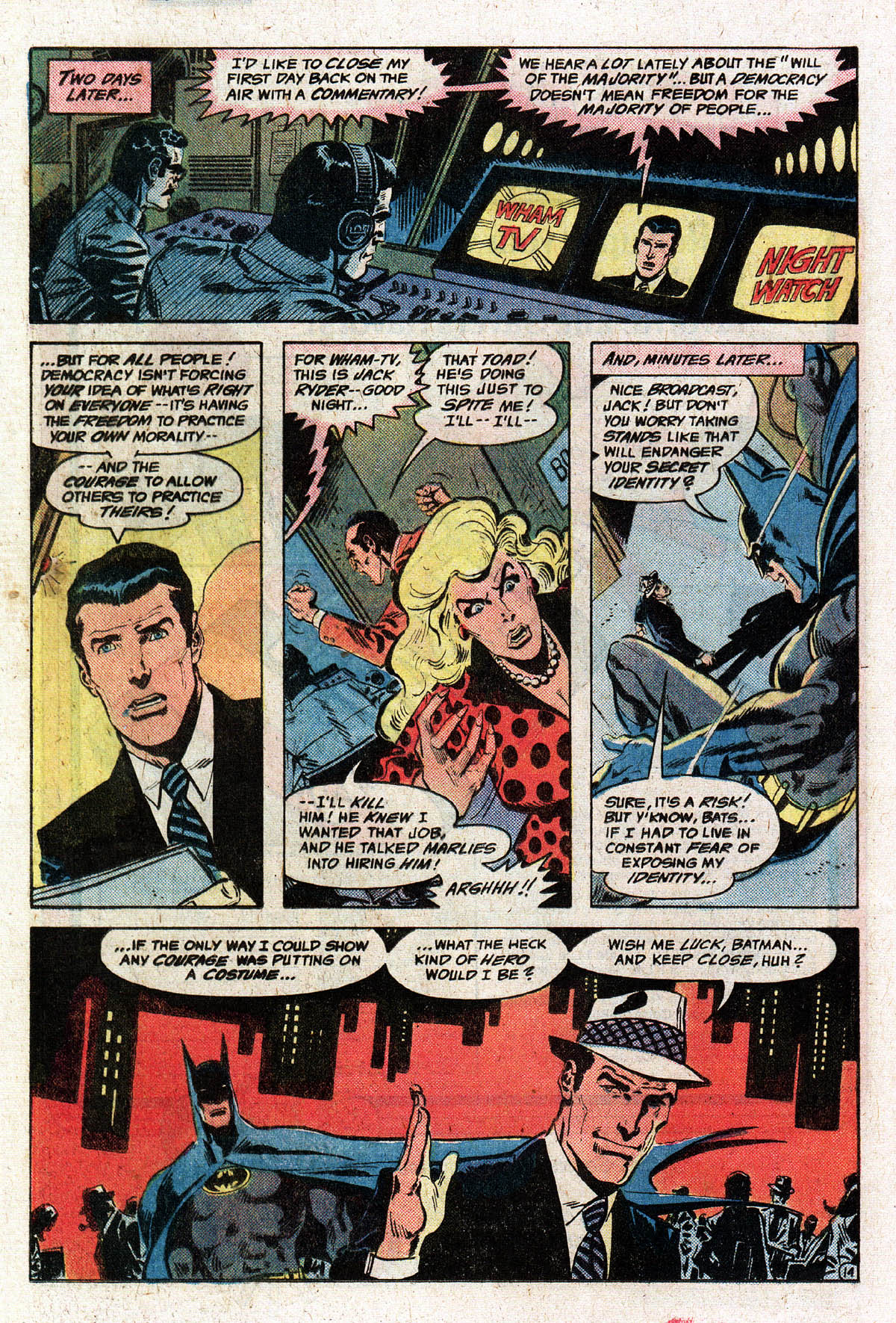 Batman nabs Wetley and takes him to the roof of the station. the creature attacks Jack Ryder and he changes into the Creeper. Wetley sees the creature, which is a psychic conduit of his hate and Wetley reveals dreams he had as a child, which match. They convince Wetley to break the circuit and the creature burns out. Thoughts: Brennert is making an allegory of the political climate, at the time. Jerry Falwell and the Moral Majority were making waves in the media, attacking it and other scapegoats for the "moral decay" of society. It was the first big push of the "Religious Right," using fearmongering tactics to stir up innocent citizens into hateful statements and even actions. They found a sympathetic ear in the new conservative administration, with its talk of "restoring traditional American values," and a "new day in America." They regurgitated debunked stories of "welfare queens" and stirred up anti-immigrant sensibilities. This was before Fox News was to become the voice of such sentiments on a daily basis; but, increasing conglomeration of media sources undermined dissenting voices, until half truths, opinion and outright lies were being repeated as factual. It was a slow process, which got worse in each subsequent decade. Self appointed moral guardians of society, whether religious figures or political groups used mass media platforms to instill fear and stir up hatred and dissent. The mass media became more concerned with ratings and advertising revenue and less on fact checking and investigative and reasoned journalism and became more sensationalistic. Reporters spent more time reporting outlandish statements than challenging the veracity of them. It grew into thing like CNN's Crossfire, where Pat Buchanan made attacks on the Left, while a centrist opponent gave mild rebuttal and the actual Left was absent from the discussion. Over the years, this got worse, until John Stewart called out the last hosts of the show for it and pointed a powerful finger at the fearmongering and CNN shut it down. Still, the damage was done with the state of modern news, where the rush to be first with the story trumped accuracy. Sensational stories got people agitated, to then sell them products that would make their lives better. Alan Brennert makes a stab at exposing what was going on, in early days, in a Batman team-up comic. It might not have been the best platform, but it is the one he had. Here is Jack Ryder exposing the method of sensationalist moral guardians... 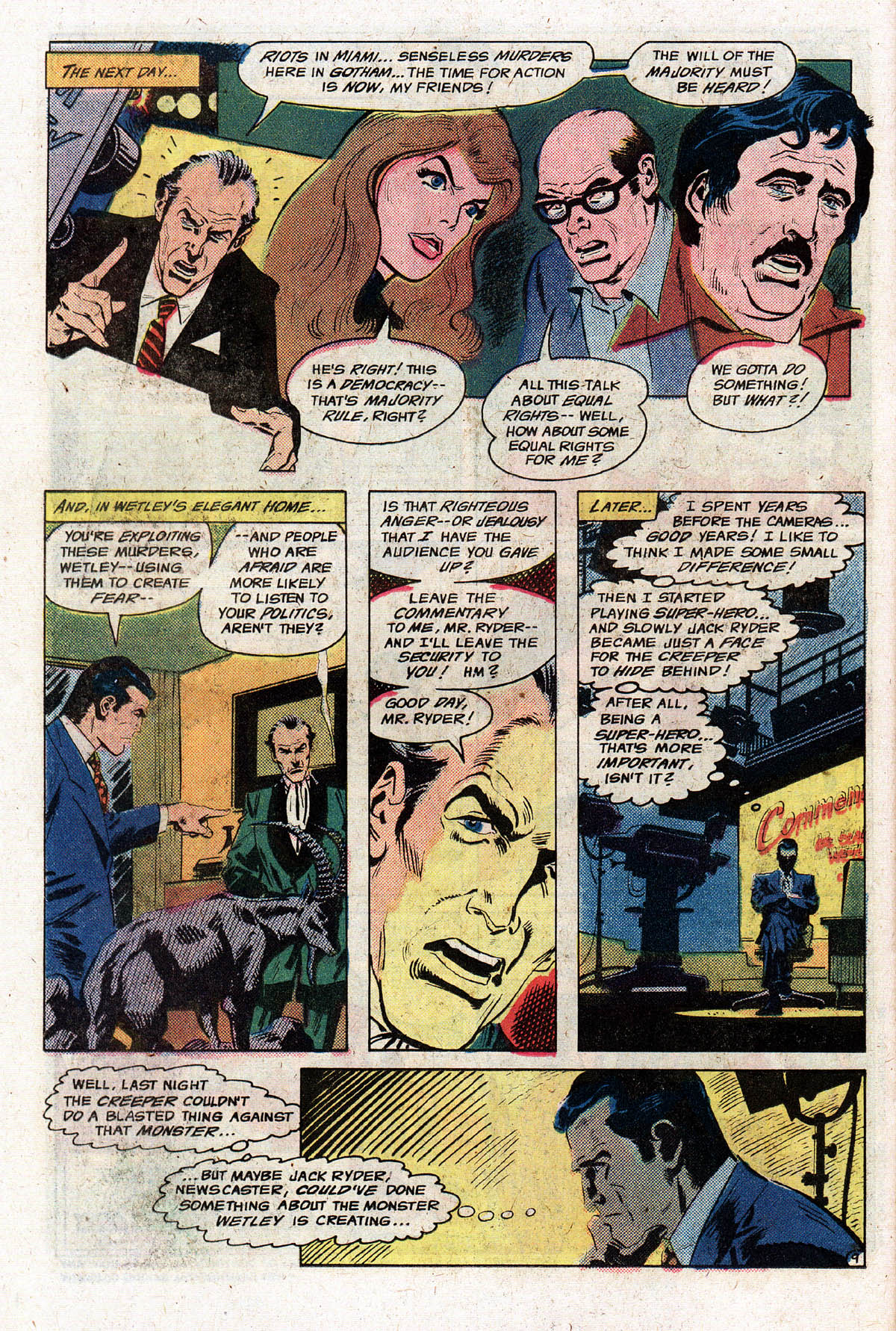 By the way, in the upper right, the last two heads are caricatures of Jim Aparo and Dick Giordano, and IO believe the woman is colorist Adrienne Roy, who colored the Batman titles and was about 28 at the time.  Roy was pretty much out of a job, when computer coloring became the norm and assignments dried up by 2000, despite retraining herself on computer systems. She died of cancer, in 2010, at age 57. This is the Alan Brennert that would be championed by Harlan Ellison, on Twilight Zone, and the thoughtful voice to the deeper aspects of humanity. Here, like Edward R Murrow, he challenges those who set themselves as the guardians of society by trying to impose their beliefs on others, rather than respect alternative viewpoints and engage in productive dialogue. It is a timely comic that fits easily into our current world, with fear driving extremism and partisanship, rather than cooperation and compromise for the greater good. The irony of this is that Brennert's politics, as seen through Jack Ryder, lie in contrast to the more black and white viewpoint of Steve Ditko. His Jack Ryder was more than a bit like Wetley, attacking those elements he sees as undercutting society, particularly anything that lay in opposition to his Randian ideals. The Question more encapsulated his ideas (and Mr A moreso); but the Creeper was often written by younger writers whose philosophies were at odds with Ditko's worldview. I don't know if the dedication was from Brennert or Giordano, as he had a long relationship with Ditko, at Charlton and DC.
|
|
|
|
Post by mikelmidnight on Dec 20, 2019 12:49:54 GMT -5
The irony of this is that Brennert's politics, as seen through Jack Ryder, lie in contrast to the more black and white viewpoint of Steve Ditko. His Jack Ryder was more than a bit like Wetley, attacking those elements he sees as undercutting society, particularly anything that lay in opposition to his Randian ideals. The Question more encapsulated his ideas (and Mr A moreso); but the Creeper was often written by younger writers whose philosophies were at odds with Ditko's worldview. I don't know if the dedication was from Brennert or Giordano, as he had a long relationship with Ditko, at Charlton and DC. This is the only one of Brennert's Batman stories I've not read (I need to get the book collection still), and the summary was a bit surprising. It sounds like he had fond memories of the original Creeper strips and needed a media-involved hero for his plot, but agreed that intrinsically Ryder's a poor fit (who else could he have used? Roy Raymond?). Also after all these years of the Creeper being presented as genuinely crazy, it's disorienting to read back to a time when he was just an average superhero chumming around with all the rest. |
|
|
|
Post by foxley on Dec 21, 2019 3:06:34 GMT -5
Len Wein and Walt Simonson do a silent story, with only narration, spoofing Edward Bulwer-Lytton's opening lines from the novel Paul Clifford. It is filled with the cliches that make up the Bulwer-Lytton Fiction Contest, which was launched in 1984, to find the worst opening lines, with rapid changes in POV. Those opening lines are indeed originally from Edward Bulwer-Lytton's novel.
However, the rest of the text in that brilliant two-pager by Wein and Simonson, comes from the first chapter of Snoopy's magnum opus "It Was a Dark and Stormy Night", as recorded by his literary agent Charles M. Schulz.  |
|